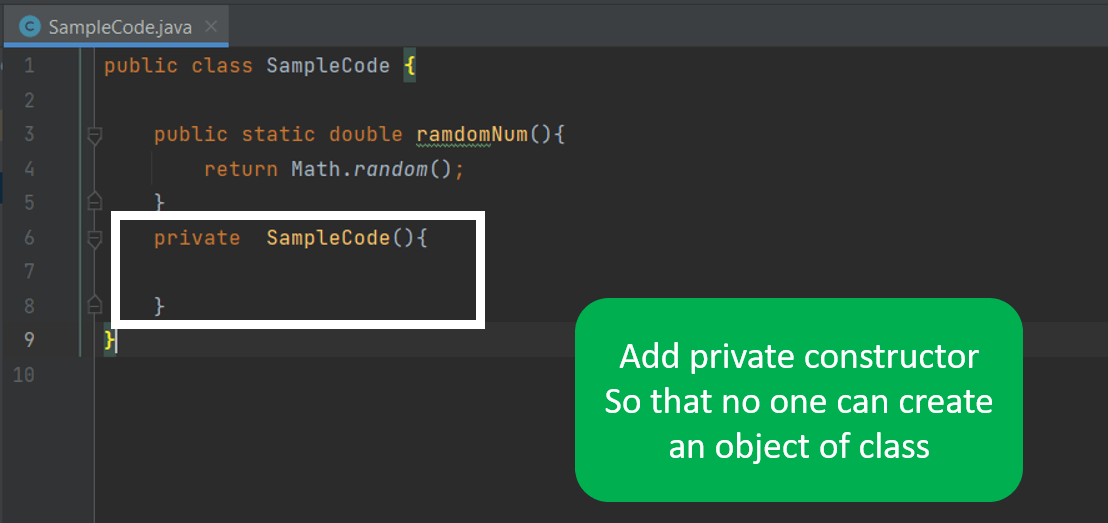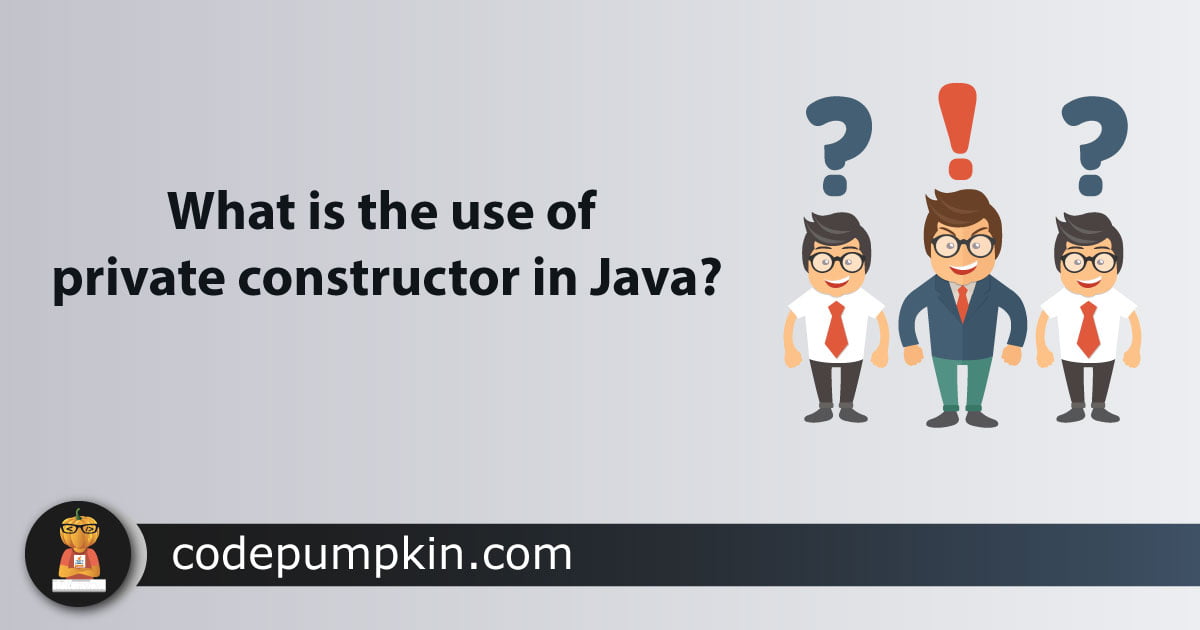java constants class private constructor
This problem is resolved using a class member instance and a factory method to return the class member. The Java Singleton design pattern ensures that there should be only one instance of a class.

Add A Private Constructor To Hide The Implicit One Bytesofgigabytes
If all the methods are static then we can use a private constructor.

. Since the caller will never need to create a Consts object a private constructor is used to enforce that policy. Singleton also use private constructor. Private String info Initial info class.
Private final String pizzaSize. We can return only the instance of that object if an object is already initialized. The private constructor allows us to restrict class instantiation to a single object instance.
Lets look at the basics for defining a constant. A private constructor is used to prevent instance initializing such as the Math final class you use in java. The utility class members called by using the class name.
Public final class FilePathHelper private FilePathHelper not called This prevents the default parameter-less constructor from being used elsewhere in your code. You cannot access its objects from outside the constructor class. Here is my rendition of the SecretAnnex.
The caller refers to these constants using static references such as ConstsEMPTY_STRING ConstsSUCCESS and so on. The singleton pattern is one of the most common places well encounter the use of a private constructor. Class Language create a public static variable of class type private static Language language.
The best practice of defining constants class in Java is. Add a private constructor to hide the implicit one. Private static final int OUR_CONSTANT 1.
Use a Class with a private constructor. Static final double PRICE43278. For example price is a variable that we want to make constant.
Generally Class which has only static members generally consider as utility class which cant be instantiated. Add a final attribute to class to restrict inheritance. This is a misuse of our utility classes as it was not designed to be instantiated.
As already mentioned constructors in Java class can have access specifiers associated with them. Though we didnt add a constructor to our utility class Java implicitly added a default public one. To achieve this we use the private constructor.
You have to put explicit public static final before each variable - you have the option of having a constructor to create an instance of the class if you want to provide additional functions related to your constants or just keep the constructor. Some of the patterns well look at will address the public or private access modifier decision. Right now the only alternative is to use reflection to instantiate the class.
Public String getSize return pizzaSize. Private constructor are most commonly used in below scenarios Classes containing only static utility methods. Private Constructor In Java.
Static final datatype identifier_namevalue. StringUtils utils new StringUtils. Therefore the SonarQube rule advises us to add a private.
Static final double PRICE43278. So when we have class which has only static members then SonarQube raise issue Add a private constructor to hide the implicit one. A subclass Student of Person that has a class status freshmen sophomore junior senior.
Below is an example in java illustrating the same. Public static final variables To prevent more than one object creation Singleton design pattern To restrict compiler from inserting default no-arg constructor when there exists no explicit constructor To utilize. All constants in class ie.
We create a class that must be derived from. That is using SecretAnnex secret new SecretAnnex. At this point we have created a class SecretAnnex that can not be instantiated in the normal way.
The members of such a constants class are excellent candidates for a static import. We will discuss more on access specifiers in our subsequent tutorials and we will also revisit constructors once again. If all the constant methods are there in our class we can use a private constructor.
Thus enabling API users to create an instance of it. Where static and final are the non-access modifiers. All fields in the interface are constants.
If this class is only a utility class you should make the class final and define a private constructor. Private SingleTonClass Private Constructor will prevent the instantiation of this class directly public static SingleTonClass objectCreationMethod This logic will ensure that no more than one object can be created. By default each variable in the interface is public static final and you cant change it.
Example of Private Constructor public class SingleTonClass Static Class Reference private static SingleTonClass objnull. Class with Private Constructor. If a constructor is declared as private then its objects are only accessible from within the declared class.
A private constructor in Java is used in restricting object creation. The main purpose of using a. We can use a public function to call the private constructor if an object is not initialized.
So I have a Person class with a name address age and email address. We create an abstract class named Content and define a user define a constructor with one argument variable with name a and an abstract method named as multiply. The syntax to declare a constant is as follows.
When you want to have a class with all constants defined and Does not require its instance any more then we declare that class as a private constructor. Its also possible to use an. It is a special instance constructor used in static member-only classes.
Private SingletonClass public static SingletonClass. Enum with a constructor. Defining Constants in Java Interface.
Private enum constructor private Size String pizzaSize thispizzaSize pizzaSize. Private constructor private Language Systemoutprintln Inside Private Constructor. Public final class SingletonClass private static SingletonClass INSTANCE.
Static final datatype identifier_namevalue. We make our constants static and final and give them an appropriate type whether thats a Java primitive a class or an enum. If our application has lots of constants we can create final class with private constructor similar to what we do in static utility class but instead of providing static method list down all your constant over there.
Enum Size SMALL The size is small MEDIUM The size is medium LARGE The size is large EXTRALARGE The size is extra large. You can JavaDoc each variable with an explanation - drawback. Use Cases of Private Constructor.
Hence we can have constructors that are private or public. The constructor of singleton class would be private so there must be another way to get the instance of that class. Add a private no-args constructor to forbid new instance creation.

Static Class Variables Are Final Are Public Are Private Are Shared By All Objects Of A Class

Add A Private Constructor To Hide The Implicit One Bytesofgigabytes

What Is The Use Of Private Constructor In Java Code Pumpkin

How To Access The Variables And Methods Of Another Java Class Youtube

Non Primitive Data Types In Java In This Tutorial I Will Explain About Non Primitive Data Types In Java With Examples And Java Tutorial Java Programming Java

C Static Class Vs Private Constructor Stack Overflow

Scala Cheatsheet Computer Science Cheating Data Services

Java Has Private Access In Stack Overflow
Java Private Constructor Benchresources Net

Java Programming Cheatsheet Java Programming Computer Science Java
Can You Override A Private Or Static Method In Java Quora

Why Java Static Constructor Is Not Allowed Journaldev

How To Implement Private Constructor In Java Edureka

What Is A Constant In Java And How To Declare It Edureka

Access Modifiers In Java Tutorial With Examples

Solved 4 Rentalcontract Java X Sammyrents Java 1 Public Chegg Com

C Static Class Vs Private Constructor Stack Overflow

Java Private Setter Saying Setter Method Is Not Used Stack Overflow

Java Tutorial Enum In Java How To Define A Constructor And Method In Enum Level Java Tutorial Java Java Programming Tutorials